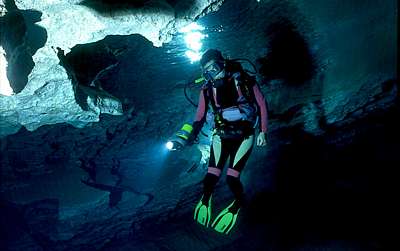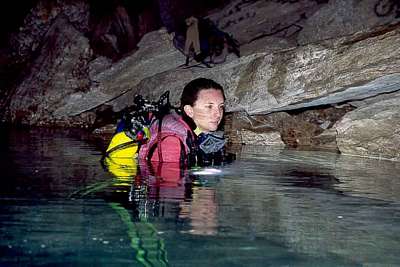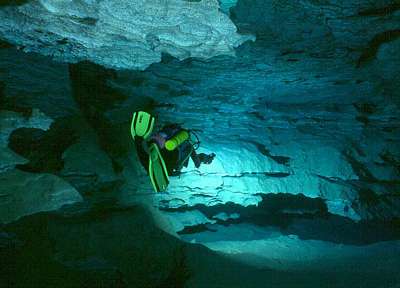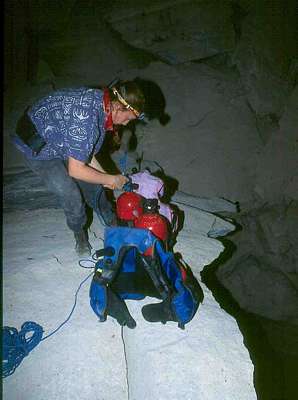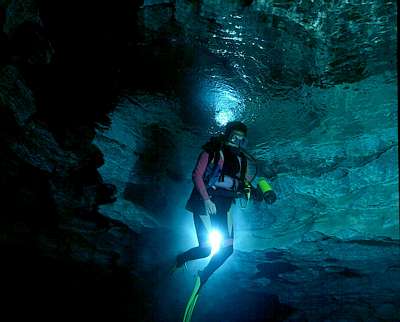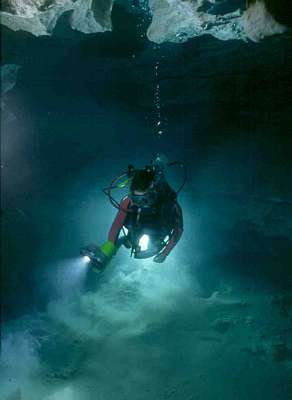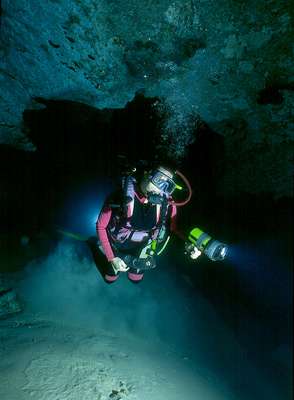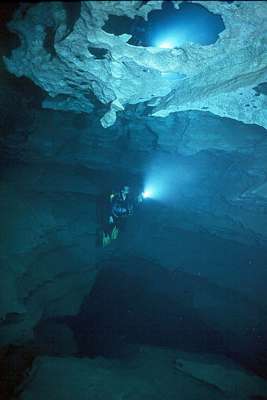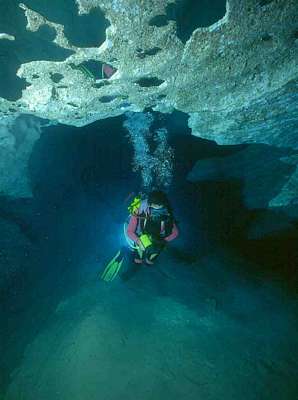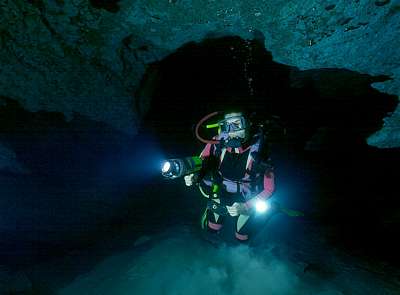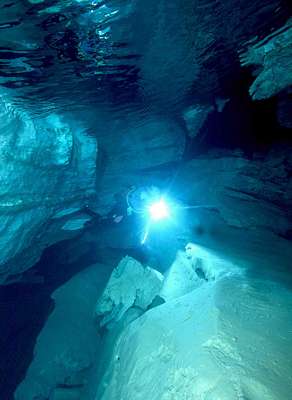








Desert Diving
AIN HITH, 1994
© 2005 by Erik Bjurström
As you drive south from Riyadh, the capital of Saudi Arabia, towards Al Kharj, you will see the desert dotted with circular areas of lush green grass. They provide fodder for some of the biggest dairy farms in the world. Their cultivation here, in the middle of the desert, is made possible by fossil water. It lies in natural reservoirs deep under the ground. They were created during a climatic period of more rain when there were green forests here. On some places near Al Kharj this water comes close to the surface and big sink holes, or "Dahls" in Arabic, have opened in the ground.
As a diver and adventurer, fascination with these holes was in the back of my mind for years. I fantasized about a complex underwater cave system waiting to be discovered.
But the holes I had seen had 200 feet (60m) vertical walls down to the water, impossible to climb with scuba diving equipment.
So things stood until I heard about a tragic accident. At Ain Hith (also spelled Ain Hit) in the Sulaiy escarpment, the wall of limestone is interrupted by a huge hole, Dahl Hith. The cave leads down 100m below the ground to end in an underground lake. I came to hear about this place when a diver, using only mask and flippers, lost his way inside the underwater cavern and drowned. As far as I knew, nobody had tried to explore it using breathing equipment. I started planning an expedition to explore the underwater cave with scuba gear.
Little did I know that it was the start of two years of incredibly hard, but fascinating work that will never really be finished.
I got a group together and we set out for Ain Hith. The cave begins with a huge opening in the porous limestone that makes up the Sulaiy escarpment. The surface limestone stratum contains some beautiful stalactite formations. The deeper, water-filled part of the cave has never been dry and there are no stalactites there. Beneath the limestone comes the bluish‑gray-colored Hith anhydrite formation. The anhydrite (calcium sulfate) is a highly soluble mineral. Water has been infiltrating into the subsurface for tens of thousands of years, dissolving the anhydrite, forming deep chimneys. Groundwater flow resulted in horizontal expansion of the cavities along joints or fractures. Together with gypsum, another calcium sulfate mineral, Anhydrite was precipitated in layers on top of the limestone, through evaporation of highly mineral-charged ocean brines. It was laid down during the end of the Jurassic Period 140 million years ago. Without this impermeable cap of anhydrite, it is almost certain that none of the oil now being tapped would have existed. A massive lid of anhydrite sits on top of the limestone formation, the oil bearing ground layer. It is named the Hith formation after Dahl Hith, where the oil explorers found the first surface outcrop of anhydrite in the kingdom. The collapse of the Sulaiy limestone into the cave created Dahl Hith. Legend tells that in 1938 the oil explorers came to visit King Abdul Aziz in Riyadh. After 5 years of fruitless drilling for oil in Dammam, the American engineers were almost giving up. The king took them to Ain Hith waterhole for an outdoor picnic. When the engineers saw the structure of the exposed ground layers, they realized that maybe they had not been drilling deep enough. They went back to Dammam to drill "a little bit deeper" and hit oil!
It's a good story, but the fact is that the discovery at Dahl Hith in 1938 took place shortly after the first big oil well discovery of a tar seep and the very same anhydrite cap, covering that oil field. The incident at Dahl Hith, however, spurred the oil explorers to extend their search of these formations. In this way, the unsuspected extent of the Saudi oil deposits was discovered. So Dahl Hith really does occupy a big place in Saudi Arabian oil history.
The cave system down to water level is divided into three separate chambers. The first room, lit by sunlight, runs down at about a 45 degree angle. It is not a difficult climb, but hard work with diving equipment on your back! The floor is covered with sharp limestone boulders from the roof that collapsed into the original cave, created when the anhydrite dissolved.
To reach the second chamber we had to crawl through a small opening. The dive equipment had to be lowered down with ropes from a shelf hanging out over the second chamber. The last of the sunlight disappeared and we had to turn on the flashlights. This chamber is about 25 x 10 meters floor area and 10 meters high. From here a larger opening leads into the third and last chamber, before the water. This chamber is about three times as big the second one and at the bottom lies the lake.
I had never seen such clear water. The surface was so still it was hard to see where the water level began. The refraction effect of the water made it looked far shallower than it actually was. The bottom shimmered light green and we could see the black hole forming the entrance to an underwater cave.
After rigging gaslights to illuminate the cave, we put on our diving equipment. We were to dive in pairs, with one diver connected to land by a lifeline. We brought weighted chemical lightsticks to mark the way back in case we lost the lifeline. Both divers had powerful torches and smaller extra ones.
I was excited. We had no idea what lay before us. I thought about the current I had seen at the waterholes in Al Kharj and wondered if we would encounter a similar current here and be swept away. I instructed the lifeline holder to keep the rope tight at all times so we could have signal contact with him. With my heavy diving‑and photography equipment, it was tricky to get the few steps down to the water, but soon we were on our way. We went over a ledge and down in a big underwater room with crystal‑clear water. With our torches we could illuminate the entire room. The bottom was covered with a very fine silt of dissolved anhydrite, like flour. When stirred up, it made the water like milk. We had to be very careful. In the silt I could see the glitter of beautiful gypsum crystals. We laid out the lightsticks to mark the entrance and went on. The cave forked in two directions. Straight ahead it narrowed into a black tunnel, while below it fell away in a narrowing canyon. We could see a black hole were it went out of sight. We decided to explore the forward route first. My partner led with the lifeline while I followed with a hand on the rope. The shapes of the walls were surreal, seamed with shelves of different strata in the cliff. They were covered with white silt as if it had been snowing. When our exhalation bubbles struck the roof, flakes of loose rock came falling down like snowfall. They did not affect the visibility. But the silt was a different matter. We had to move very carefully, gliding through the water with almost no movements. Neutral buoyancy was imperative. The tunnel narrowed more and more. Finally, after swimming about 150 meters, we struck the roof and came to a dead end.
We turned back. The line‑holder was doing his job well and we had no problem in following the rope as we retreated. We decided to see if the canyon below led further. We swam down in a zig‑zag course avoiding the silt‑covered shelves. We saw several side‑tunnels leading in other directions but followed the main shaft. It became narrower and narrower. At last we ended up at an opening only big enough to let one person through. I looked at my depth‑gauge: 17 meters, then glanced back the way we had come. I could see the rope had snagged the rock on several places, meaning that we no longer had contact with the line‑holder. Also we had kicked up silt that now came rolling down towards us like fog...
...Desperately signaling to my partner to turn back, I began a slow ascent, following the rope hand over hand. I saw the gleam of my partner's torch, and knew that he was following. Fear started to slow down my thinking. I knew I had plenty of air left but I started to breathe heavily. I felt I was not getting enough air. I had to lie down and control myself before I did something irrational like leaving the rope for an uncontrolled ascent. I went on and came to a rock were the rope was jammed. I had to put the light aside. In total blindness I loosened the rope with my fingers, entirely by feel.
We went on. After several similar stops, the rope was finally free and I was back in touch with the line‑holder and my feeling of security came back. Soon we found the lightsticks marking the tunnel entrance. Our land support team was worried since they lost contact with us. We were shaken by this incident and I was glad to see the sun again after an exhausting climb back up to the main entrance.
Before we turned back, my partner had looked through the hole and seen a black continuation. That last hole was an irresistible challenge for further exploration to find out what was on the other side.
This experience made me realize we had to make better safety preparations. I needed more expertise and backup equipment for a serious push on. I was now entering the world of serious cave diving.
With a stroke of luck I got a telephone call a few weeks later that changed everything. The caller was Mike Gibson, an experienced cave diver, who had dived the famous caves in Florida and Puerto Rico. He had just arrived in Saudi Arabia and called me to find out about the diving in the Red Sea.
On the remote chance there would also be cave diving in Saudi Arabia, he had brought all his advanced cave diving equipment.
Mike was delighted to find a fellow cave diver so soon. For me it was a big boost to my confidence. In no time, plans were drawn to expand the exploration of the cave.
I went back with Mike and Arlene Foss, an experienced diver who had been with me on my shark expeditions, to push on further. Mike went down first to secure a permanent lead rope through the passage where we had turned back. He had double, independent breathing systems that would give him a backup in case of equipment failure. The rule is to use one‑ third of the air for swimming in, one‑third coming back and one third spare for any problems. He had two lights fixed to a helmet and a main halogen light. He also carried two reels of rope, one for the main guideline and one to use for any detours from the main shaft. He went away and came back 45 minutes later to an eagerly awaiting surface party. He was bubbling with excitement. There was a continuation and it was big! Arlene's and my exploration had to wait until the next week for the silt to settle. It was an excited cave-diving party that left Dahl Hith that day and wild plans were made up for the future.
Next week Arlene and I went down, Arlene first. We headed straight for the entrance to the second underwater chamber. Mike had done an excellent job with the rope. He had tied it to rocks so it went a foot over the silt. Arlene could not avoid stirring up the silt in the narrow tunnel at the cave floor so I had to go through blind. Carefully, I pulled myself through with my tanks hitting the roof.
...There were no stalactites and stalagmites that could indicate that it once had been dry. From the entrance hole a slope went downwards. I could see another tunnel opening 50 meters farther on. I saw tiny tracks in the silt like the tracks you see in the desert sand, made by insects. So there must be life here in this eternally dark place!
The tracks showed what a stable environment existed in this underwater cave. Like the shoeprint of an astronaut on the moon, they remained undisturbed until covered with more silt. I soon found the origin of the tracks: a tiny, transparent, shrimp‑like creature. The light made the red hemoglobin visible. They are amphipods, a widespread family of crustaceans.
We have not been able to identify this species. It does not fit any of the descriptions we have found. Considering the isolation of this place, they could very well have evolved here, remaining unknown to science. They must be blind since there is no light here. How is it possible that life can exist in a place where the sun never reaches? There is a minimal current in the water and maybe nutrients are transported from areas exposed to sunlight. Or maybe these creatures are the top of a food chain which starts with bacteria drawing energy from chemicals such as sulfur and hydrogen like the life forms recently discovered on the ocean floor.
I continued down the slope, following the rope and went through the next opening at a depth of 26 meters. I passed through a 90 degree bend into a smaller chamber which had two tunnels going out from it, straight ahead and left. I went straight, following the rope and came into a different landscape...
...The rope ended here, tied on to a rock. I went around the perimeter of this chamber and saw a narrow tunnel going right. By now we were far inside the cave system, 30 meters deep. It was just too big a risk to go on in this very narrow tunnel at this depth. We started going back.
On my way back I suddenly heard an eerie rumbling and echoing sound that made my blood freeze. It sounded like falling rocks. I was waiting for the roof to collapse over me. I looked up and saw that the roof was dotted with pits that had filled up with our breathing air. As we came back, the air started to move, running along the roof to higher areas and creating this sound.
We are continuing to explore the Ain Hith cave system. It is a hard tedious, slow, task since we can only do one dive at every visit. Then visibility is gone. To climb down and up from the water in sometimes 45 centigrade heat with 20 kilos on your back is a test of endurance. The limestone is like a Swiss cheese with many chambers going in different directions. I created a permanent camp at the lake so we only had to supply it with fresh tanks every time. Every move on every dive has to be carefully planned beforehand. The slightest mistake would mean having to come back another time to get the pictures we want. The pictures in this article have required about 40 dives over two years.
People ask me why I go into a black hole where there are no fish or coral to see. I'd say the answer is a feeling of curiosity -- to find out what is around the corner.
When I go through the small entrance to the inner cave at Dahl Hith, it is like stepping down from a spacecraft on the moon. You hover in weightlessness in a place with a surreal landscape where nobody has been before. And it is beautiful in there, a virgin landscape of shapes and spaces. But it can quickly become a deathtrap. When asked about claustrophobia, I answer: "Yes, but it is healthy to be a little bit afraid; it sharpens your instinct for self preservation." It is a strange temptation to go on and discover new chambers. It means penetrating small tunnels in total blindness in deep water. It is coupled with anxiety for what could happen, but the sirens are singing their song to lure us further inside.
Erik Bjurström
